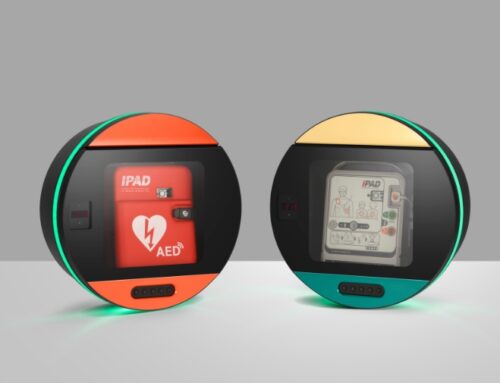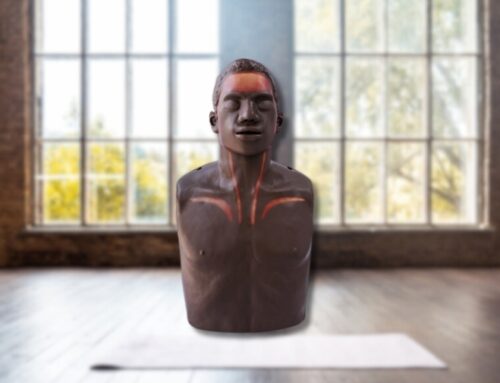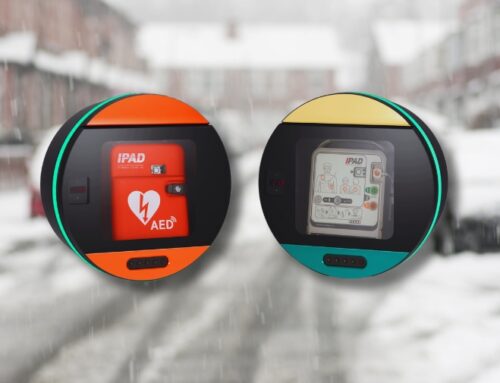[vc_row][vc_column][vc_column_text]One of the most common questions we get asked here at WEL Medical is “where can I store a defibrillator if I buy one?”
The answer is – almost anywhere!
While there are some best practices to consider, the truth is that a defibrillator is a relatively small, and surprisingly resilient piece of technology that’s built to last. So if you’re worried about not having somewhere suitable to store one after a purchase – don’t be.
With that in mind, here we’ll look at some unusual places you can place one, with a focus on storing your defibrillator and keeping it safe.
Before we jump into those, though, first we have to address one of the most important best practices of defibrillator care.[/vc_column_text][/vc_column][/vc_row][vc_row][vc_column][vc_column_text]
What temperature should a defibrillator be kept at?
The ideal temperature range for storing a defibrillator is between zero and 50 degrees centigrade. Any warmer and the battery can prematurely discharge, and the water-based gel inside the defib pads might not work as well as intended due to evaporation. Too cold, and the battery can drain, while the gel in the pads can freeze, making the pads useless in an emergency.
As you’ll see below, the many places you can keep a defibrillator are wide and varied, but please do bear in mind the temperature factor when considering where to store a defibrillator of your own, and move yours if temperature changes suddenly make it unsuitable – particularly during the colder parts of the UK winter.
Surprising places you can keep a defibrillator
Our blog post ‘Places You Wouldn’t Think Need a Defib (But Really Do!)’ outlined some public areas and leisure services that can benefit from an automated external defibrillator. However, what about the specifics of storing your defibrillator and keeping it safe?
These are our top five suggestions for exactly where to store a defibrillator if you’re thinking of getting one. (Some of them might surprise you!)
1. In your car (in the spring, summer and early autumn)
[/vc_column_text][vc_empty_space height=”16px”][vc_single_image image=”2688″][vc_empty_space height=”16px”][vc_column_text]Defibrillators are designed to be portable, so it would make sense that you might want to take yours with you when you journey around. This suggestion for where to store a defibrillator is particularly handy if you’ve purchased (or are thinking about purchasing) your defib to take to sporting occasions, like local grassroots football matches or amateur athletics meets, or even if you’re a trader at a local market.
Thankfully, the three iPAD models we sell are small enough to fit neatly in your boot with room to spare, and will keep there just fine as long as the temperature doesn’t drop too low. On particularly cold days, however, you’ll want to take it out and put it indoors instead. Perhaps somewhere like…
2. Inside a cupboard, cabinet, locker or wardrobe
Whether you’re moving your AED into a business space or residential environment, you’ll be pleased to know the same handy dimensions that made it suitable for your car’s boot also make it well-suited to sitting inside typical indoor storage spaces.
We would, however, advise keeping it away from cupboards with boilers or hot water tanks, because of the temperature issues we mentioned earlier. We’d also recommend keeping it out of the loft, because as well as being too cold, an attic space is often far less accessible. When considering where to store a defibrillator, you don’t want anything slowing you down if and when it’s needed in a hurry.
3. Underneath or inside furniture
Another of the many places you can keep a defibrillator is right beneath you as you sit and watch your evening-time telly! Even in its carry case, our best-selling iPAD SP1 is svelte enough to fit under many high-footed sofas, or in other low-down places like ottomans or storage beds.
That’s great news if you’re the one charged with looking after your defib for the local neighbourhood watch scheme, but also brilliant for accommodations ranging from hotels to homeless shelters, or even meeting spaces like Quaker Houses and plush function rooms. That way, such important lifesaving equipment can be kept safely out of sight, while still being fully accessible if needed.
4. Behind a bar or service counter
[/vc_column_text][vc_column_text] Speaking of hospitality spaces, another area within that category that’s well-suited to housing an AED is a bar. Of course, the back office may be more tempting, but if someone collapses in a busy pub or club, you might want to move fast, and the bar is almost always the central area in such a place. It’s a similar case with cafes and workplace cafeterias, too. Keeping a defibrillator beneath the counter in a drawer, or up on the wall inside a first aid cabinet, can often be a real lifesaver. Surprising, but true!
Speaking of hospitality spaces, another area within that category that’s well-suited to housing an AED is a bar. Of course, the back office may be more tempting, but if someone collapses in a busy pub or club, you might want to move fast, and the bar is almost always the central area in such a place. It’s a similar case with cafes and workplace cafeterias, too. Keeping a defibrillator beneath the counter in a drawer, or up on the wall inside a first aid cabinet, can often be a real lifesaver. Surprising, but true!
5. Anywhere outdoors within a heated defib cabinet
Our final suggestion for storing your defibrillator is the one you probably expected. But that’s because it’s such a great option.
A specialised heated defib cabinet is designed to house an AED while protecting it from the elements and keeping it at a suitable temperature, and their versatility really is remarkable. They can be fixed securely to external walls almost anywhere, and even placed in pop-up structures like old phone boxes – as we covered recently in our Lifesaving Festive Stories blog.
At WEL Medical, we design and supply DefibSafe defibrillator cabinets. These IP65 rated cases come with or without a code lock, and in a hi-vis yellow (plus the option of a green door) that people are bound to notice and remember. To unlock the coded lock, all you need to do is follow the instructions printed on the front, which involves calling a given number and providing the operator with the code printed on the DefibSafe door.
Wherever you place your defib, make it public knowledge
In many areas of the country, the direction given on a DefibSafe cabinet is to call either 999 or 112. That works because those defibrillators are registered with a specialist national defibrillator network that’s there specially to help people find and access their nearest AED in a life or death situation.
It’s called The Circuit, and we recommend that all new AEDs be registered with it. You can find out more about it here.
We also strongly recommend that wherever you store your defibrillator, it should ideally be as accessible as possible to anyone who needs it in the local vicinity – and that you communicate to everyone who needs to know about the location and how to access it.
Storing your defibrillator and keeping it safe is incredibly important, because without doing so, you can’t guarantee it will work in a crisis. But making sure people can find and access it when they need it is also an ongoing concern.
We understand that keeping your defib safe and secure but also accessible might feel like a contradiction in terms. So if you need more advice on how to do this, please get in touch with us – we’ll be happy to talk through your situation and offer advice.[/vc_column_text][vc_empty_space][/vc_column][/vc_row][vc_row][vc_column][vc_column_text]
Related articles
- Places You Wouldn’t Think Need a Defib (But Really Do!)
- Five Things You Should Do When You First Get Your Defibrillator
- Choosing The Right Defibrillator
- What Happens When You Use A Defibrillator?
- Christmas Miracles: Lifesaving Festive Stories
[/vc_column_text][/vc_column][/vc_row]





